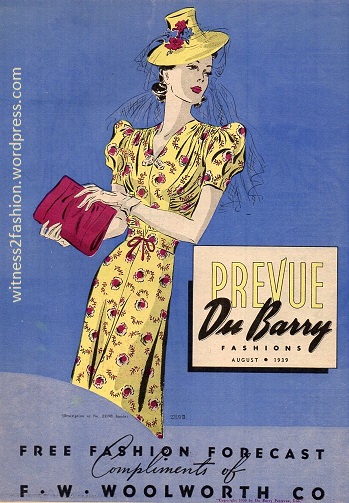
Cover, Du Barry Fashions Prevue store flyer, August 1939. What a hat!
Du Barry patterns were sold by Woolworth’s — we called it the “dime store,” or the “five and ten,” as in the 1931 song lyric, “I found a million dollar baby in a five and ten cent store.” ( Click here to hear it .)
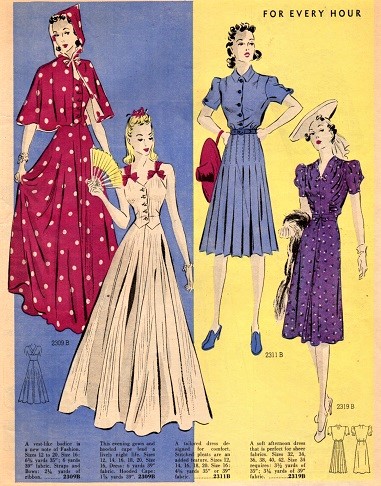
Page 6, Du Barry pattern flyer, Aug. 1939.
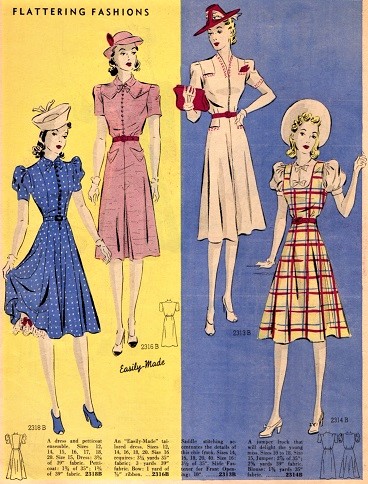
Page 5, Du Barry pattern flyer, Aug. 1939.
The Du Barry flyer from August 1939 shows relatively few patterns — but illustrates the same patterns in different “views” on several pages.
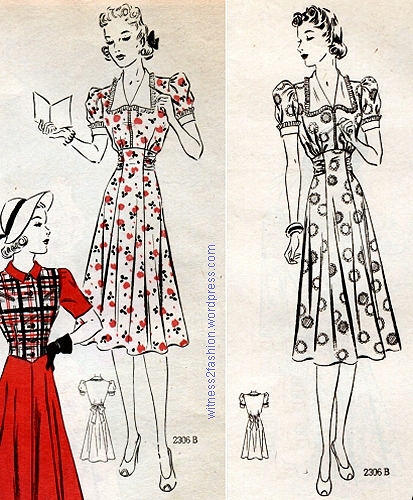
Du Barry pattern 2306 was illustrated on page 2 and on page 4 of the August 1939 flyer.
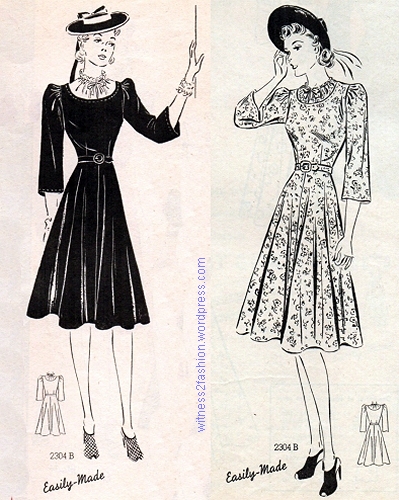
Du Barry pattern 2304B, an “Easily-Made” frock for sizes 12 to 20, appeared on both page 3 and page 5; August 1939.
Here are three versions of the dress featured on the cover, Du Barry pattern 2319.
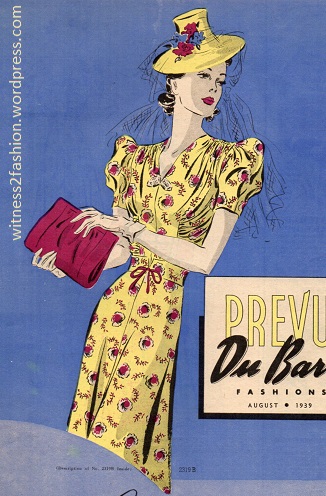
Du Barry pattern 2319 in yellow, as shown on the cover. Aug. 1939.
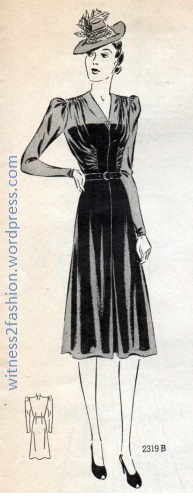
“Choose this soft afternoon frock for sheer flattery. Sizes 32 through 42. Slide fastener for side placket 9”. Du Barry 2319B illustrated in a sheer fabric, page 3 of flyer, Aug. 1939.
Earlier dresses with side openings used snaps. By 1939 a slide fastener was mentioned in the pattern description, so side zippers must have been common, but not yet taken for granted with all dresses.
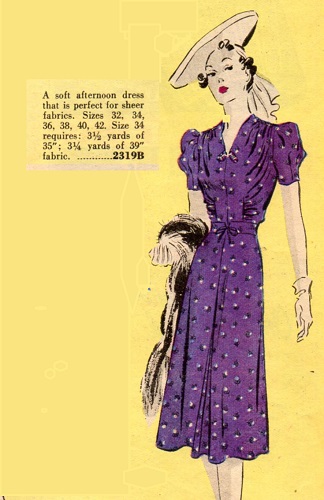
“A soft afternoon dress that is perfect for sheer fabrics.” Du Barry 2319B illustrated in a purple print fabric. Store flyer, page 6, Aug. 1939. Available in sizes 32 through 42 bust measurement. Note the sophisticated expression on the model — she is an adult woman, not a teen.
You can usually tell which designs are aimed at younger women and teens by the faces and illustration style, but the size range — 12 to 18, or 12 to 20 — is also a clue.
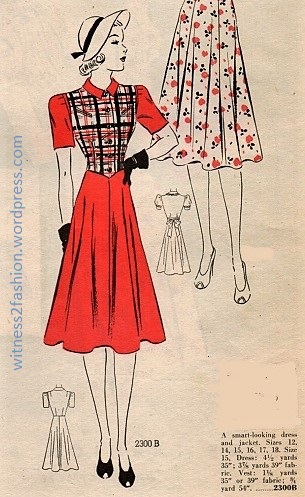
“A smart-looking dress and jacket,” Du Barry pattern 2300B, was available for sizes 12, 14, 15, 16, 17, and 18.

“Easily-Made” frock for sizes 12 to 20; Du Barry pattern 2307B from 1939.
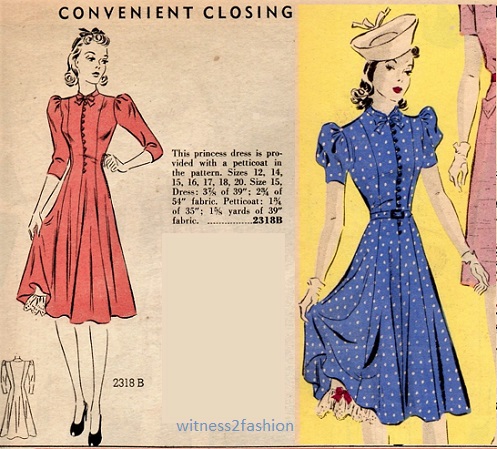
“A dress and petticoat ensemble” for younger women and teens, sizes 12 through 20. Du Barry pattern 2318B from Aug. 1939 flyer, illustrated on two pages. “Convenient closing” referred to other dresses, not this one.
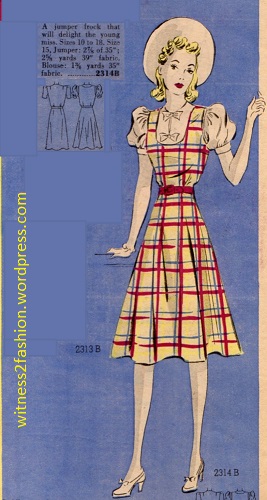
Du Barry pattern 2314B is a “jumper frock that will delight the young miss. Sizes 12 to 18.” 1939.
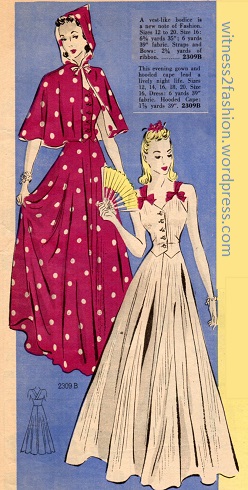
The evening cape with hood accompanies a gown with a “vest-like bodice” for young or small women size 12 to 20. Du Barry pattern 2309B; Aug. 1939 flyer.
Tailored styles like this pink dress ( Du Barry 2316B) and the sporty pleated one (2311B) were also for sizes 12 through 20. This sizing dates back to the time when patterns for teens and small women were sized by year, rather than by bust measure. (See “Size 16 years. What Does That Mean?”
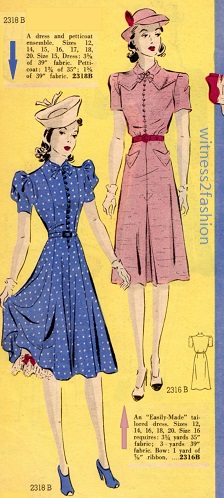
Right: this pink tailored dress, Du Barry 2316B, is for teens and small women, sizes 12 to 20.
It could be made with a zipper front closing instead of buttons, as shown in white with red stitching (Scroll down.)
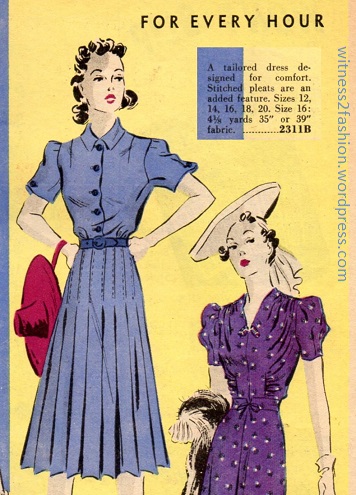
Left, “A tailored dress designed for comfort. Stitched pleats are an added feature.” Du Barry pattern 2311B, store flyer, Aug. 1939. Sizes 12 to 20.
The Du Barry/Woolworth’s pattern flyers also contained ads for other products, from chewing gum to sanitary belts.
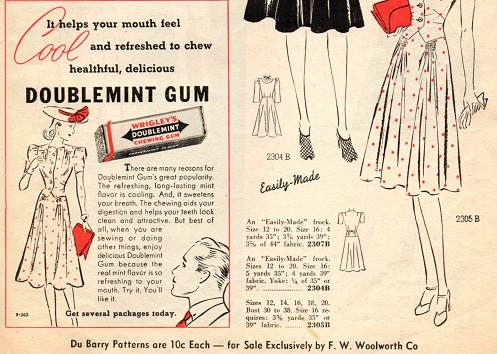
DuBarry pattern 2305B appeared twice on page 5 — once in an ad for Wrigley’s Doublemint Gum.
“Du Barry Patterns are 10 Cents Each — for sale exclusively by F. W. Woolworth Co.”
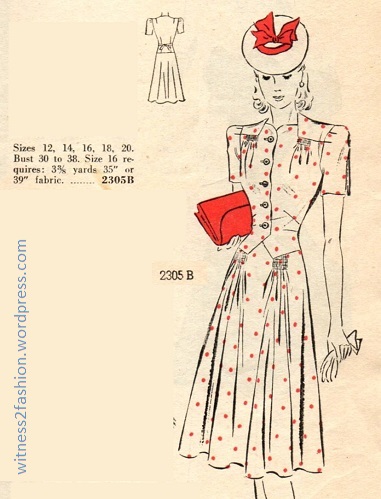
Du Barry 2305B was available in sizes 12 through 20 and for women bust sizes 30 to 38 inches. 1939. A tie in back ensures a snug fit.
I was pleased to see so many dresses made with visible zippers — a style introduced by Parisian designers in 1936-37. (This is mentioned briefly in Robert Friedel’s book, Zipper: An Exploration in Novelty.)
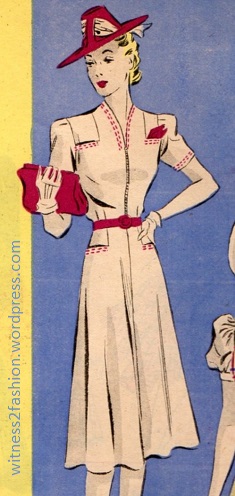
Du Barry pattern 2313 B illustrated with a slide fastener down the front and trimmed with parallel rows of top-stitching. August 1939 store flyer, p. 6. Sizes 14, 16, 18, 20 and 40.
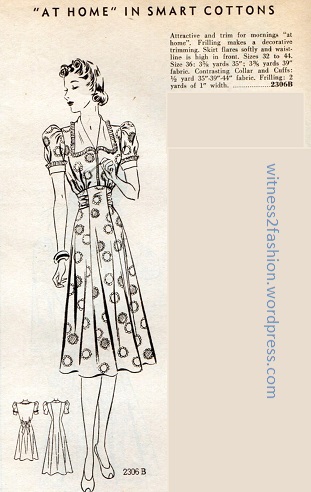
“Attractive and trim for mornings at home,” Du Barry housecoat pattern 2317B from 1939 has a zipper front closing.
[Schiaparelli is usually credited with being the first, but that’s not strictly accurate. One Butterick pattern with both practical and decorative zippers appeared in 1928. Schiaparelli did encourage the manufacture of colored plastic zippers.]
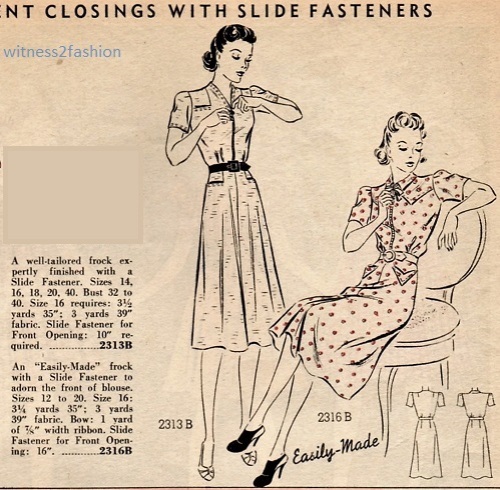
“Convenient closings with slide fasteners” were featured on DuBarry patterns 2313B (again) and 2316B, from 1939. Page 7 of store flyer.
Is it possible that DuBarry patterns with zipper closings were featured because the same flyer contained this Talon ad?

An advertisement for Talon slide fasteners from a Woolworth’s Du Barry store flyer, Aug. 1939, p. 7. “For decorative purposes — ask for the TALON plastic fastener.”
Although in common use, the word “zipper” technically belonged to the B.F. Goodrich company. (See Flappers, Galoshes, and Zippers for more about the history of the slide fastener.)
My mother still wore a long housecoat very much like this one in 1947 or so; hers was a large floral print in blue seersucker, without a collar. It had these sleeves, but it zipped down the front.

Du Barry housecoat pattern 2317 was shown in two versions, on two different pages. Aug. 1939.
(I call this blog “witness2fashion” because I saw clothes like this being worn.)
